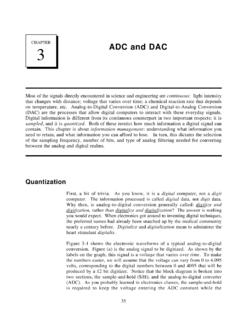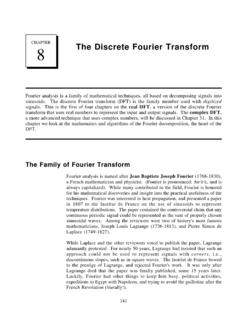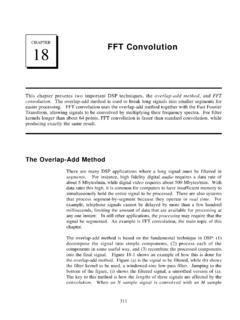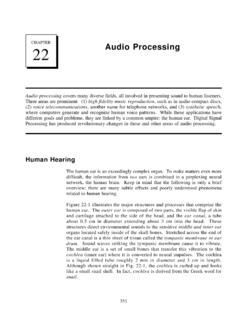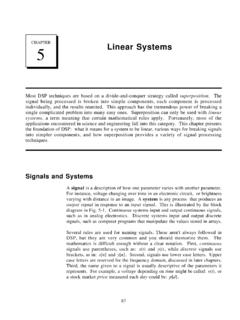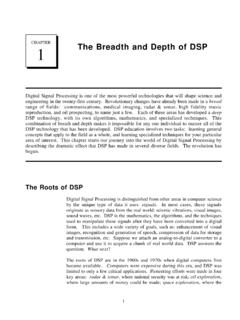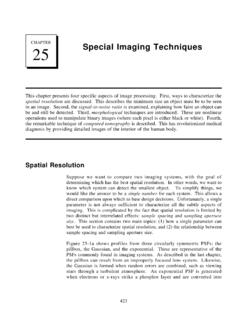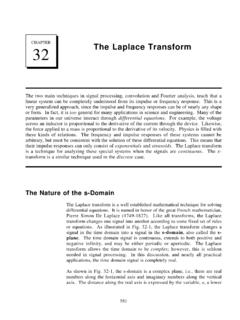Transcription of Data Manipulation Math Calculation - Digital …
1 503 CHAPTER28 Digital signal ProcessorsDigital signal processing is carried out by mathematical operations. In comparison, wordprocessing and similar programs merely rearrange stored data . This means that computersdesigned for business and other general applications are not optimized for algorithms such asdigital filtering and Fourier analysis. Digital signal Processors are microprocessors specificallydesigned to handle Digital signal processing tasks. These devices have seen tremendous growthin the last decade, finding use in everything from cellular telephones to advanced scientificinstruments.
2 In fact, hardware engineers use "DSP" to mean Digital signal Processor, just asalgorithm developers use "DSP" to mean Digital signal processing . This chapter looks at howDSPs are different from other types of microprocessors, how to decide if a DSP is right for yourapplication, and how to get started in this exciting new field. In the next chapter we will take amore detailed look at one of these sophisticated products: the Analog Devices SHARC DSPs are Different from Other MicroprocessorsIn the 1960s it was predicted that artificial intelligence would revolutionize theway humans interact with computers and other machines.
3 It was believed thatby the end of the century we would have robots cleaning our houses, computersdriving our cars, and voice interfaces controlling the storage and retrieval ofinformation. This hasn't happened; these abstract tasks are far morecomplicated than expected, and very difficult to carry out with the step-by-steplogic provided by Digital computers. However, the last forty years have shown that computers are extremely capablein two broad areas, (1) data Manipulation , such as word processing anddatabase management, and (2) mathematical Calculation , used in science,engineering, and Digital signal processing .
4 All microprocessors can performboth tasks; however, it is difficult (expensive) to make a device that isoptimized for both. There are technical tradeoffs in the hardware design, suchas the size of the instruction set and how interrupts are handled. EvenThe Scientist and Engineer's Guide to Digital signal Processing504 data ManipulationMath CalculationWord processing , databasemanagement, spread sheets,operating sytems, signal processing ,motion control, scientific andengineering simulations, movement (A B)value testing (If A=B then.)
5 Addition (A+B=C )multiplication (A B=C )TypicalApplicationsMainOperationsFIGURE 28-1 data Manipulation versus mathematical Calculation . Digital computers are useful for two generaltasks: data Manipulation and mathematical Calculation . data Manipulation is based on movingdata and testing inequalities, while mathematical Calculation uses multiplication and addition. more important, there are marketing issues involved: development andmanufacturing cost, competitive position, product lifetime, and so on. As abroad generalization, these factors have made traditional microprocessors, suchas the Pentium , primarily directed at data Manipulation .
6 Similarly, DSPs aredesigned to perform the mathematical calculations needed in Digital 28-1 lists the most important differences between these twocategories. data Manipulation involves storing and sorting instance, consider a word processing program. The basic task is tostore the information (typed in by the operator), organize the information(cut and paste, spell checking, page layout, etc.), and then retrieve theinformation (such as saving the document on a floppy disk or printing itwith a laser printer).
7 These tasks are accomplished by moving data fromone location to another, and testing for inequalities (A=B, A<B, etc.). Asan example, imagine sorting a list of words into alphabetical order. Eachword is represented by an 8 bit number, the ASCII value of the first letterin the word. Alphabetizing involved rearranging the order of the wordsuntil the ASCII values continually increase from the beginning to the endof the list. This can be accomplished by repeating two steps over-and-overuntil the alphabetization is complete. First, test two adjacent entries forbeing in alphabetical order (IF A>B THEN.)
8 Second, if the two entriesare not in alphabetical order, switch them so that they are (AWB). Whenthis two step process is repeated many times on all adjacent pairs, the listwill eventually become another example, consider how a document is printed from a wordprocessor. The computer continually tests the input device (mouse or keyboard)for the binary code that indicates "print the document." When this code isdetected, the program moves the data from the computer's memory to theprinter. Here we have the same two basic operations: moving data andinequality testing.
9 While mathematics is occasionally used in this type ofChapter 28- Digital signal Processors505y[n]'a0x[n]%a1x[n&1]%a2x[n& 2]%a3x[n&3]%a4x[n&4]% a0 a1 a2 a3 a4 a5 a6 a7 Input signal , x[ ]Output signal , y[ ]x[n]x[n-1]x[n-2]x[n-3]y[n]FIGURE 28-2 FIR Digital filter. In FIR filtering, eachsample in the output signal , y[n], is foundby multiplying samples from the inputsignal, x[n], x[n-1], x[n-2], .., by the filterkernel coefficients, a0, a1, a2, a3 .., andsumming the , it is infrequent and does not significantly affect the overallexecution comparison, the execution speed of most DSP algorithms is limited almostcompletely by the number of multiplications and additions required.
10 Forexample, Fig. 28-2 shows the implementation of an FIR Digital filter, the mostcommon DSP technique. Using the standard notation, the input signal isreferred to by , while the output signal is denoted by . Our task is tox[]y[]calculate the sample at location n in the output signal , , . An FIR filtery[n]performs this Calculation by multiplying appropriate samples from the inputsignal by a group of coefficients, denoted by: , and then addinga0,a1,a2,a3, the products. In equation form, is found by:y[n]This is simply saying that the input signal has been convolved with a filterkernel ( , an impulse response) consisting of.
